
In South Africa, saving for retirement is crucial due to uncertainties surrounding government pensions and the rising cost of living. To encourage individuals to save, the government provides substantial tax incentives through various retirement savings options. These tax benefits are aimed not only at easing immediate financial pressures but also at enhancing the growth of retirement funds over time. But what are these benefits, and how can they impact your financial future as you plan for retirement?
Key Takeaways
- Tax Deductions: Contributions to retirement savings are tax-deductible up to 27.5% of taxable income or remuneration, with an annual cap of R350 000. This reduces taxable income and lowers tax liability.
- Tax-Free Growth: Investments in retirement funds grow tax-free, allowing contributions to compound over time without incurring taxes on gains.
- Favourable Withdrawal Terms: Up to one-third of retirement savings can be withdrawn as a lump sum upon retirement, tax-free up to R500 000, providing significant tax relief and financial flexibility in retirement.
About Arcadia Finance
Get Your Loan Effortlessly with Arcadia Finance: No Application Fees, Trusted Lenders, and a Seamless Experience Access loans from 19 compliant lenders, fully regulated by South Africa’s National Credit Regulator. Experience a smooth process with no application fees and financial solutions designed just for you.
What Are Retirement Savings?
Retirement savings are the funds set aside during your working years to support yourself financially once you retire. These savings are built up through various financial instruments, such as pension funds, provident funds, and retirement annuity funds. The primary aim of retirement savings is to provide a stable income when you are no longer earning a regular salary. Well-managed retirement savings help cover living expenses, healthcare costs, and other needs during retirement, ensuring you can maintain your standard of living and financial independence.
To make the most of your retirement savings, understanding how much you can safely withdraw without depleting your nest egg is crucial. The 4% Rule offers a simple strategy that aligns perfectly with the tax benefits you gain by investing in retirement accounts.

Different Types of Retirement Savings Accounts and Tax Benefits
In South Africa, individuals can choose from several types of retirement savings accounts, each offering unique features and benefits. Here’s an overview of the primary options:

Pension Funds
Pension funds are employer-based retirement savings plans primarily funded through contributions from both the employer and employee. Contributions are typically based on a percentage of the employee’s salary, and the benefits received upon retirement depend on factors such as salary at the time of retirement and years of service. Pension funds are a common choice for employees in larger corporations or public sector jobs. The investment returns and the retirement benefits (up to certain limits) are tax-free, making them an attractive savings vehicle.
Tax Benefits
- Contributions: Contributions made by both the employer and employee are tax-deductible, up to certain limits (27.5% of the greater of remuneration or taxable income, with an annual cap of R350,000). This provides immediate tax relief by reducing the taxable income of the contributor.
- Investment Returns: The growth of investments within the pension fund is tax-free, meaning that any interest, dividends, or capital gains accumulated within the fund do not attract income tax, capital gains tax, or dividend withholding tax.
- Payouts: At retirement, up to one-third of the total benefit can be taken as a lump sum. This lump sum has favourable tax treatment, with the first R500,000 being tax-free, while the remaining amount is taxed at progressive rates. Regular pension payments received thereafter are taxed according to standard personal income tax rates, but the initial lump sum benefit significantly reduces the tax burden.
Even with well-structured retirement savings, some retirees may find themselves in need of extra financial support. A pensioner’s loan offers retirees the flexibility to manage unforeseen expenses while maintaining their financial independence.

Provident Funds
Provident funds operate similarly to pension funds, with contributions made by both the employer and employee. The key difference lies in the payout at retirement. Members of provident funds can withdraw their entire retirement benefit as a lump sum, whereas pension funds typically offer a combination of a lump sum and a monthly pension. Recent legislation aims to align the tax treatment of provident funds with that of pension funds, especially regarding the tax on retirement benefits.
Tax Benefits
- Contributions: Contributions to provident funds are tax-deductible up to the same limits as pension funds, reducing your current taxable income.
- Investment Returns: Investment growth within provident funds is tax-free, which supports the accumulation of savings and compound growth over time.
- Payouts: Previously, provident fund members could withdraw their entire benefit as a lump sum upon retirement. Recent changes now require a portion to be annuitized, though some flexibility remains. The lump sum portion benefits from the same tax-free threshold as pension funds.

Retirement Annuity Funds (RAFs)
Retirement annuities are private pension plans that individuals can contribute to, regardless of their employment status. This makes them suitable for freelancers, self-employed individuals, or those whose employers do not offer pension plans. Contributions to retirement annuities benefit from annual tax deductions up to a set limit. The funds in RA accounts are locked in until retirement, allowing the savings to grow without being taxed on investment returns, which compound over time.
Tax Benefits
- Contributions: Contributions to retirement annuity funds are particularly beneficial from a tax standpoint. They offer deductions up to 27.5% of taxable income or remuneration, with a cap of R350,000 per year. This can lead to substantial tax savings, especially for those with higher incomes.
- Investment Returns: The returns on investments within retirement annuities are free from all forms of tax, which can greatly improve the effective return on these investments over the long term.
- Payouts: Upon retirement, RA holders can take up to one-third of the fund value as a tax-favoured lump sum (with the first R500,000 tax-free). The remaining amount must be used to purchase an annuity, which provides a regular income taxed according to the retiree’s current tax bracket.
Maximising tax benefits on retirement savings can make a huge difference in your long-term financial security. Before making key investment decisions, read Essential Factors to Consider When Planning Your Retirement Income to ensure you’re optimising your tax advantages while securing a stable future.

Preservation Funds
Preservation funds act as an intermediary holding account for retirement savings when an individual leaves an employer before reaching retirement age. By transferring their pension or provident fund benefits to a preservation fund, individuals can avoid immediate tax penalties associated with cashing out their retirement savings early. Like other retirement funds, preservation funds offer tax-free investment growth, but no additional contributions can be made once the funds are transferred.
Tax Benefits
- Contributions: Although additional contributions are not permitted in preservation funds, the rolled-over funds retain their tax-deductible status and continue to benefit from tax-free growth. This allows individuals changing jobs to keep their accumulated retirement savings in a tax-efficient state.
- Investment Returns: The growth of investments within preservation funds is completely tax-free, in line with other retirement funds.
- Payouts: Withdrawals from preservation funds at retirement receive similar tax treatment as those from pension and retirement annuity funds. This includes the tax-free lump sum benefit and the option to annuitize the remaining balance, providing strategic tax planning opportunities.
As SARS updates its compliance framework, it’s wise to stay informed on policy shifts. Don’t miss the Key Change Announced by SARS Ahead of 2025 Tax Season which highlights new procedural requirements that may affect even those claiming retirement tax benefits.

Living Annuities
After retiring, individuals have the option to convert their retirement savings into a living annuity. This product provides a regular income during retirement, with the annuitant having the flexibility to choose the amount of annual income (within regulatory limits) they withdraw based on their financial needs. The balance of the funds continues to be invested and grows tax-free, although the income drawn from a living annuity is subject to income tax.
Tax Benefits
Contributions: There are no contributions per se to living annuities as they are purchased with the accumulated capital from another retirement fund at retirement.
Investment Returns: Investment returns within a living annuity continue to accrue tax-free, which can significantly impact the sustainability of the fund by maximizing the growth of the remaining capital.
Payouts: Withdrawals from a living annuity, which can be adjusted annually within prescribed limits, are treated as taxable income. The flexibility to adjust the withdrawal rate allows retirees to manage their tax liability by aligning income needs with tax-efficient withdrawal strategies.
For a comprehensive understanding of how tax deductions work on retirement contributions, the South African Revenue Service (SARS) provides detailed guidelines.
With the Two-Pot Retirement System, savers can better manage both short-term access to funds and long-term growth, which makes tax planning more efficient. By allowing part of your retirement savings to remain untaxed until withdrawal, this system complements other tax benefits you may already have in place, providing a strategic approach to retirement savings.

How to Maximize Tax Benefits
To optimize the tax benefits associated with retirement savings in South Africa, consider the following strategies:
- Max Out the Contribution Limit: Aim to contribute the maximum allowable percentage of your income (27.5%) to your retirement funds, up to the tax deduction limit of R350,000 per year. This approach will reduce your taxable income as much as possible, lowering your overall tax liability.
- Start Early: Begin contributing to your retirement savings as early as possible to benefit from compound interest over time. Starting early also allows you to distribute your contributions more comfortably without straining your finances, especially during your peak earning years.
- Consistent Contributions: Regular contributions help smooth out the cost of fund units over time, known as dollar-cost averaging. Consistency is crucial for building a substantial retirement fund, as it leverages the power of compound growth.
- Use Bonus or Windfall Gains: Allocate a portion of any bonus, inheritance, or windfall gains to your retirement funds. These additional contributions can significantly increase your retirement savings and enhance your tax benefits.
- Reinvest Tax Refunds: If you receive a tax refund, consider reinvesting it into your retirement savings. This can accelerate your savings growth and help you reach the maximum contribution limits more quickly.
- Diversify Retirement Vehicles: Utilize different types of retirement funds, such as pension funds, provident funds, and retirement annuities. Diversifying helps manage risks and take advantage of the distinct tax benefits each type offers.
- Review Annually: Regularly review your contributions and overall retirement strategy each year. This will help you adjust your contributions based on changes in your income, tax laws, and personal financial goals.
While traditional retirement savings plans offer significant tax benefits, the rise of cryptocurrency introduces new avenues for wealth accumulation. How Cryptocurrency Is Shaping the Future of Retirement Savings explores how digital assets are revolutionising long-term investment strategies, offering potential tax efficiencies and growth opportunities that challenge conventional pension funds.
Limits on Contributions and Tax Benefits
When planning for retirement, it’s important to understand the challenges and considerations related to contribution limits and tax benefits:
Contribution Caps
In South Africa, deductible contributions are capped at 27.5% of the higher of your taxable income or remuneration, with a maximum limit of R350,000 per year. Contributions exceeding this limit do not qualify for a tax deduction and can complicate your financial planning.
Tax Benefits Capping
While tax relief on retirement savings is substantial, it is constrained by these limits. Understanding how these caps apply to your individual financial situation is essential for effective retirement planning, ensuring you don’t rely on unrealistic expectations for tax deductions.
Did you know that making the most of your Retirement Annuity (RA) and Tax-Free Savings Account (TFSA) can lead to major tax savings? Understanding how to leverage these benefits can help you keep more of your hard-earned money. Read more about the tax advantages of maximising contributions in Why You Should Maximise Your Retirement Annuity and Tax-Free Savings Account Contributions.

Common Mistakes to Avoid in Retirement Planning
| Common Mistake | Description | Potential Impact | Solution |
|---|---|---|---|
| Underestimating Retirement Needs | A common mistake is underestimating the amount of money needed in retirement. Consider factors like longevity, inflation, and unexpected medical costs. | Inadequate funds in later years | Use retirement calculators and consult with financial advisors to set realistic savings goals. |
| Overlooking Fees | High management fees or administrative costs can erode the value of your retirement savings over time. Always assess the fee structure of any retirement fund. | Reduced investment returns | Choose funds with lower fees and regularly review expense ratios to ensure they remain competitive. |
| Failure to Diversify | Relying solely on one type of retirement account or investment can expose you to higher risk. | Increased risk and potential for loss | Diversify investments across different asset classes and retirement vehicles to spread risk. |
| Neglecting Regular Reviews | Not regularly reviewing your retirement plan can lead to misalignments with your current financial situation or goals. Economic conditions and personal circumstances change. | Missed opportunities and misaligned financial strategies | Schedule annual reviews of your retirement plan to adjust contributions and investments as necessary. |
| Delaying Contributions | Starting late in your career limits the benefits of compounding interest and increases the financial burden as you try to catch up. | Insufficient retirement savings | Begin contributing to retirement accounts as early as possible and increase contributions whenever feasible. |
The right investment choice can save you thousands in taxes. Learn how different investment vehicles affect your tax savings in our comparison of Retirement Annuity vs Tax-Free Savings Account vs Bond, helping you make the most of every rand you put away.
Conclusion
The tax benefits for retirement savings in South Africa aim to encourage individuals to secure their financial future while offering immediate fiscal relief. By fully utilizing these incentives, such as significant deductions on contributions and tax-free growth on investments, savers can greatly improve their retirement outlook.
Remember, a well-thought-out approach to retirement savings not only maximizes these tax benefits but also ensures a stable and comfortable retirement.
Frequently Asked Questions
You’re eligible to claim a tax deduction on contributions to retirement funds, up to 27.5% of the higher amount between your taxable income and remuneration, with an annual limit of R350,000.
No, the returns on investments within pension, provident, and retirement annuity funds, including interest, dividends, and capital gains, are not subject to income tax, capital gains tax, or dividend withholding tax.
At retirement, you can withdraw up to one-third of your total pension or provident fund as a lump sum. The first R500,000 of this lump sum is tax-free, with any amount above this threshold taxed at progressive rates.
Yes, you can continue to contribute to your retirement funds after the age of 65 and still benefit from tax deductions, provided you have taxable income against which the deductions can be claimed.
Contributions exceeding the tax-deductible limit of R350,000 per year cannot be deducted in the current tax year. However, excess contributions can be carried forward to the next tax year and may be deducted then, subject to the same limits.
Fast, uncomplicated, and trustworthy loan comparisons
At Arcadia Finance, you can compare loan offers from multiple lenders with no obligation and free of charge. Get a clear overview of your options and choose the best deal for you.
Fill out our form today to easily compare interest rates from 19 banks and find the right loan for you.


